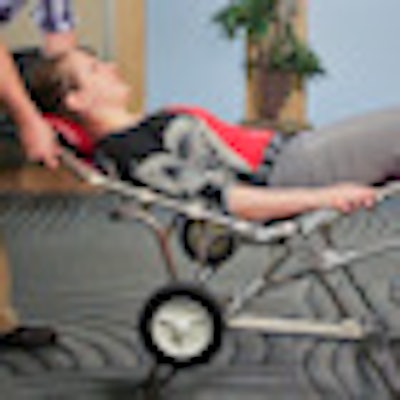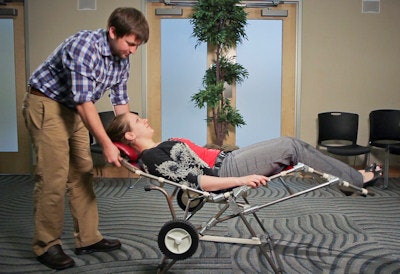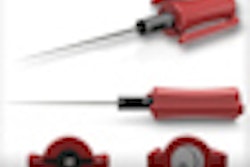
Former Purdue University student Leah Kenttämaa-Squires spent much of the summer of 2009 in a dental chair having all her amalgam fillings replaced. When the time came for the industrial design major to develop her senior thesis, she tapped the long and frustrating experience for inspiration.
The result is the Mantis, a lightweight, multipurpose, collapsible dental chair designed initially for use by medical providers in Third World settings.
The patent-pending Mantis, which fully reclines into an ergonomically correct position without the aid of gears or a motor, also folds into a dolly to help transport supplies. With its minimal weight and small size when collapsed, doctors can more easily overcome one of the primary challenges to providing care in remote areas: transporting their dental chair. The Mantis can also be taken on commercial airliners, eliminating the need for expensive, chartered flights that are often required to transport conventional -- and much heavier -- chairs.
Creating the concept
After pinpointing a dental chair as the subject of her thesis, Kenttämaa-Squires refined its focus with the help of her dentist, John James, DDS. She interviewed him to get his advice and satisfy a requirement of the thesis.
"He said there was definitely a market for a portable chair because everything that exists now is really expensive, and there's nothing special about them -- it's just a chair," she recalled. "He also suggested looking into Third World dentistry."
First she had to make the chair collapsible. To accomplish that, she recruited her friend Kyle Amick, then a biomedical engineering student, who is currently working to obtain a master's degree in mechanical engineering.
"We were seeing what was out there and I came across a mechanism that I got excited about because, well, that's the sort of thing I get excited about," Amick laughed.
He was looking at the functionality of the Zero Gravity Chair, a foldable reclining chair. With Amick's changes to Kenttämaa-Squires' design, the operator behind the chair could recline it instead of the person seated in it.
 |
| Leah Kenttämaa-Squires and her collaborator Kyle Amick demonstrate the Mantis portable dental chair. |
"It also moves the center of gravity around so that it takes almost no effort to move somebody up or down," Amick explained.
“It takes almost no effort to move somebody up
or down.”
— Kyle Amick
The main pivot holding most of the weight is situated directly below the body's center of mass. The Mantis also fully reclines, while portable chairs currently on the market have a limited ability to do so.
Once the initial design was in place, the pair then developed and tested various versions of the device.
"One of them, when it was collapsed, made me think of a dolly," Kenttämaa-Squires said. "I realized that, with all the other equipment that a dentist would inevitably need, why not make it a dolly, too?"
"The question came down to whether or not certain members could hold the loads necessary to make it a functional dolly," Amick added. "A couple pieces of the frame would need to be heavier steel, but the rest can be lightweight stuff, like you find on lawn chairs."
Manufacturing partner needed
The pair is optimistic that the chair's price point will be less than most portable chairs on the market today, which cost roughly $1,500 to $2,000. With the assistance of the Purdue Research Foundations Office of Technology Commercialization, they hope to find a manufacturer. They estimate that the Mantis could be on the market within two years once a deal is struck.
Surprisingly, Kenttämaa-Squires initially encountered resistance to her idea from her professor.
"In my degree, they're usually just looking for something pretty, so it wasn't really appreciated that I made a working type rather than a small model that looks like the finished product," she explained. "But then when I submitted it to the James Dyson Awards, which is how it got so publicized, they really seemed to appreciate it because there are so many engineers in that community."
The Mantis was an international finalist for the award, distributed by the James Dyson Foundation, whose goal is to encourage the next generation of engineers.
More information about the Mantis chair and a demonstration are available in a video on YouTube.



















